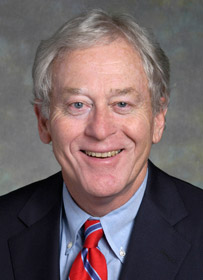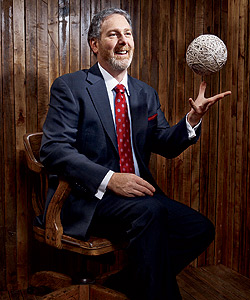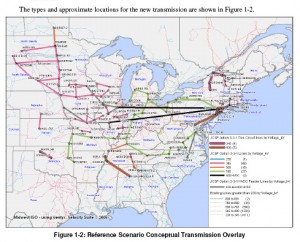Byron Starns on both sides of the fence
July 6th, 2010
I’ve just by utter accident discovered a few things…
We all remember Byron Starns, attorney for Excelsior Energy’s Mesaba Project, the coal gasification project from hell. Check his bio – CLICK HERE – he’s done some amazing things, that Reserve Mining case in particular.
Now let’s take a walk back on memory lane, the 2003 Prairie Island bill, where the “Environmental Coalition”, i.e., Izaak Walton League, MCEA, ME3/Fresh Energy, and Xcel and Tom Micheletti did a deal that advance wind some, let Xcel continue using Prairie Island and increased cask storage, and opened the door for Micheletti’s Excelsior Energy and their IGCC plant that they’d been promoting since the 2002 session. On one hand, the “Environmental Coalition” including MCEA, in the middle we have Xcel, and on the other we have Tom Micheletti and Excelsior Energy…
Here’s the 2003 Prairie Island bill:
Minnesota Session Laws 2003 – 1st Special Session, Chapter 11
Here’s what it did for Mesaba (as if calling burning garbage “renewable” wasn’t enough):
Excelsior Energy Mesaba Project related parts of 2003 Chapter 11
When the Power Purchase Agreements for Excelsior Energy’s Mesaba Project came up at the PUC, MCEA intervened, both as a party and representing others:
To look at the full docket, go to www.puc.state.mn.us and “Search Dockets” and search for PPA docket “05-1993” and Siting docket “06-668.”
And look who filed a Notice of Appearance for Excelsior Energy dated April 27, 2006:
And representing Excelsior Energy in the Siting Docket dated September 26, 2006:
And look who is noted in the MCEA Annual Reports as providing legal services to MCEA in 2005 and 2006, look in the fine print, why it’s Byron Starns!
Oh, but that’s not all, look who joins the Board of MCEA in 2007 … and remains through 2008… and 2009 according to his bio on the LSD site — why, it’s Byron Starns again!:
Board of Directors, Minnesota Center for Environmental Advocacy, 2007–2009 (linked)
His bio states he was on the MCEA board in 2009, but the 2009 IRS 990 does not list him as having been on it at reporting year end.
I just spoke with Byron Starns, who, with the forwarning to don his Kevlar vest, was kind enough to entertain a few questions, and said that (close to quotes but not quite):
MCEA has an ethical requirement, that everyone on the Board must make full disclosure of interests and conflicts, and that when issues do come up, anyone with a conflict has to leave the room. He said he didn’t participate in any decisions related to energy matters for MCEA. He does not recall if the fact that he was on MCEA’s board was disclosed in the Excelsior Energy Mesaba Project PPA or Siting dockets. Also, he noted he is no longer on the Board of MCEA.
I don’t recall any disclosure about this — do you?
Is it “not a conflict” because MCEA’s interests and the interests of their “clients” the Waltons and Fresh Energy are so closely aligned with those of Excelsior Energy because of that 2003 agreement?
Minnesota’s nuclear moratorium — gone?!?!?!
May 8th, 2010
I read with horror news of Rep. Bill Hilty’s amendment eliminating the moratorium on new nuclear generating plants that passed in a House Ominous Bill this week. WHAT ARE THESE YAHOOS THINKING? The Senate already approved it, and now the House… and I just can’t see Pawlenty doing anything but signing it with glee.
(sudden feeling of ice picks going through temples… buried in brain… electricity applied…)
AAAAAAAAGH!
Is this the “price” of the rollback of exemptions of utilities from eminent domain laws? Is it an attempt to look like they’re repealing it when “conditions” mean it won’t happen? (like those that said Obama really doesn’t mean what he’s saying about coal gasification or transmission, he knows better) Is it more of the same deal-making that took the Renewable Development Fund away from PrairIe Island Indian Community, or the enviro sell-outs that gave us the 2005 Transmission bill? Minnesota’s second nuclear waste storage facility at Monticello, now two piles piling with no plan in sight, PERMANENT?
What I’m hearing about this from various little birdies….
… is NOT encouraging — ooooohhhhhhh do I have a headache…
… apparently NO ONE OBJECTED!
NO ONE OBJECTED?!?!?!?!
AAAAAAAAGH!
Here’s the bill as it is on the Senate site:
Here’s how Rep. Bill Hilty, Chair of House Energy, amended it:
Page 4, after line 11, insert:
“Sec. 4. [216B.1695] NUCLEAR POWER PLANT; COST RECOVERY.
(a) The commission may not allow any of the following costs attributable to the construction of a nuclear generating plant begun after July 1, 2010, to be recovered from Minnesota ratepayers until the plant begins operating at a monthly load capacity factor of at least 85 percent:
(1) planning, design, safety, environmental, or engineering studies undertaken prior to construction; or
(2) the costs of obtaining regulatory approval, including permits, licenses and any other approval required prior to construction from federal, state and local authorities.
(b) The commission may not allow any of the following costs attributable to the construction of a nuclear generating plant begun after July 1, 2010, to be recovered from Minnesota ratepayers:
Journal of the House – 98th Day – Thursday, May 6, 2010 – Top of Page 11584
(1) any construction costs exceeding the projected construction cost of the generating plant and any ancillary facility constructed by the utility to temporarily or permanently store nuclear waste generated by the plant, as identified in the utility’s certificate of need application submitted under section 216B.243;
(2) the costs of insuring the plant against accidents that exceed the cost of insurance for a fossil fuel plant of equivalent capacity; or
(3) contributions from the plant to provide and maintain local fire protection and emergency services to the plant in case of an accident.
(c) Except for regulatory costs of state agencies, no revenues from taxes or fees imposed by the state of Minnesota may be used to pay for any portion of the preconstruction, construction, maintenance, or operating costs of a nuclear generating plant, or to assume any financial risk associated with an accidental release of radioactivity from the generating plant or an ancillary facility constructed by the utility that owns the generating plant to temporarily or permanently store nuclear waste generated by the plant.
Sec. 5. Minnesota Statutes 2008, section 216B.243, subdivision 3b, is amended to read:
Subd. 3b. Nuclear power plant; new construction prohibited; relicensing. (a) The commission may not issue a certificate of need for the construction of a new nuclear-powered electric generating plant provided that the certificate of need application contains a separate estimate of preconstruction and construction costs that does not include any of the costs identified in section 216B.1695, paragraphs (a) and (b).
(b) Any certificate of need for additional storage of spent nuclear fuel for a facility seeking a license extension shall address the impacts of continued operations over the period for which approval is sought.”
Renumber the sections in sequence and correct the internal references
Amend the title accordingly.
Way below is the list of yeas and nays, do send each of them a missive:
The ones who voted against it are the strangest set of bedfellows! But KUDOS TO THEM!
If you click on this to look at the whole back and forth with amendments, scroll to p. 11579 to start. Here’s the vote:
The bill was read for the third time, as amended, and placed upon its final passage.
Those who voted in the affirmative were:
Those who voted in the negative were:
Pawlenty gets slapped!
May 6th, 2010
You know life is good in Minnesota when the Supreme Court slaps The Green Chameleon, Gov. Tim Pawlenty!
(FYI, it’s been a busy week in CapX 2020 transmission line land, the scoping hearings, today is Cannon Falls. Check it out on www.nocapx2020.info)
Here’s the decision:
In short:
Wind up to ELPC Transmission Strategy Meeting
March 28th, 2010
And the pitch? Nothing new, just RE-AMP toadying for utilities, but I’m waiting for Howard “The Slow” Learner to prove me right, again… and to see how far they go to promote transmission.
April 20 & 21st is Learner’s/Environmental Law & Policy Center‘s and RE-AMP’s “invitation only” transmission strategy workshop, at their office in Chicago, and I surmise much about their goal and strategy based on my many past experiences with transmission promoters. This meeting is very unlike the Sierra Club transmission strategy meeting in West Virginia last spring, a great group of people who understand the purpose of transmission, were actively engaged in fighting it and who have been successful in slowing down that big web of 500kV/765kV lines known as Project Mountaineer. Here in the Midwest, it’s a little different. An example:
What is ELPC doing to develop and expand transmission? Transmission lines across South Dakota moving this power out of state means it comes into Minnesota — funny how that works. What is ELPC doing about the coal plants in queue in the Dakotas?
What is the goal of ELPC’s invitation-only Transmission Strategy Meeting?
Anyway, it was no surprise to me — Learner saw I was on the list and has slammed the door in my face! Imagine that! SNORT! It seems that people with a lot of working knowledge of transmission, knowledge of history, and knowledge of the parties involved are not welcome. Specifics on this meeting are below.
Don’t drop the ball, Howard! Will Howard Learner and ELPC be the utilities’ water boy for transmission that’s planned stretching from the Midwest to the East Coast or acknowledge that more big transmission is not needed or wanted? And why would anyone want to advocate for transmission to the East Coast if the East Coast doesn’t want it? Will they respect the East Coast’s solid “NO!” to Midwest transmission? How ethno-geo-centric will they be?
Here are a few posts with links to the primary documents of NYISO & ISO-NE, NY’s Deputy Secretary of Energy, the 10 Mid-Atlantic Governors letter, etc.
DUH… eastern states don’t want our transmission
Offshore transmission, NOT transmission from Midwest
Eastern Governors stand up against Transmission!!!
The windup? Today’s Chicago Tribune has a disturbing article about transmission, foreshadowing the meeting three weeks from now:
For example, from the article:
The estimated cost to move that wind power east could range from $64 billion to $93 billion in 2009 dollars and would require 17,000 to 22,000 miles of transmission lines to be built in the eastern half of the country alone, according to the Eastern Wind Integration and Transmission Study (EWITS) published in January and prepared for the National Renewable Energy Laboratory.
Just a reminder, Matt Schuerger who worked on this EWITS (or “nitwits”) study is the same one who, together with Beth Soholt, asked me and several others to sell out on the SW MN 345kV line. At that time, he was at ME3 (after a stint at District Energy) and is listed as a consultant on Izaak Walton 990s, and Beth Soholt, Izaak Walton League (formerly of MAPP). FYI – Wind on the Wires is a GRANT, not an organization — it’s listed on the Izaak Walton 990s as a “program” despite having a Minnesota non-profit established (CLICK HERE for Secretary of State link). From May, 2001 NWCC minutes:

Matt Schuerger is, in 2022, a 2nd term Commissioner at Minnesota PUC (notice his bio doesn’t mention his working for Waltons, ME3/Fresh Energy, and Wind on the Wires!).
Color me naive, I really didn’t have a clue (other than the enviros’ obscene deal on Prairie Island in 1994) until that meeting in question, it was on or about Sept. 8, 2001, when Beth and Matt asked about 6-7 of us who were likely intervenors in that docket to sell out. “What would you need to approve of this line?” (the SW MN 345kV line, PUC Docket 01-1958). I asked what they were getting and what they’d share, and what they were getting was pissy and they got pissier the more questions I asked, particularly Matt, who made empty threats about walking out — DUH, please, leave! The most important question they didn’t address was, “What about the big long list of coal in queue on p. 29 of the study, waiting for the transmission that they were promoting?” Defensive pissyness, unwillingness to address the big picture, and silence. Schuerger and Soholt, they were so B Squad about it that afternoon at the Loring Cafe, Dinkytown, in 2001. That was the year that “Wind on the Wires” got $4.5 million to promote transmission. That amount was ramped up for the next grant, and the focus of their deal became clear when one agreement was posted on the TRANSLink docket. A o coupfle days later, “Wind on the Wires” got an Energy Foundation/McKnight grant of $8.1 million. $8.1 MILLION! Hmmmmm…
The Energy Foundation/McKnight funded and orchestrated promotion of transmission has been shameless, as bad as the enviro support for coal gasification, their transmission efforts ranging from attempts to gain endorsement of the regional SEED group (organizations that as a whole knew nothing about transmission) to legislative “it’s a deal, a package deal and it’s a good deal” changes desired by utilities, to NWCC “concensus building” to supportive intervention in transmission dockets. That agenda continues despite clear evidence that midwest transmission supports coal, our RES that does not link an increase in renewables with a decrease in coal, MISO policy that has a goal of displacing natural gas with coal (see “Conclusions” in ICF – Midwest ISO Benefits Analysis) , and decreased demand and a conservation mandate, such that transmission is not needed now and probably not needed ever. Whose interests are these organizations acting in? Their interests, their funders’ interests. Where’s consideration of the public interest?
What did they agree to back then? Here’s one example that’s public:
Take a closer look at “Wind on the Wires” that is a subset of the Izaak Walton League. Do members and chapters of the Izaak Walton League have a clue what this organization is advocating? Though there is a Minnesota “non-profit” registered, as above, it remains a “program” on the Izaak Walton League IRS 990s and Beth Soholt is an employee of the Waltons. From the website, here’s the address, same as the Waltons:
Office Location
Wind on the Wires
1619 Dayton Avenue, Suite 203
St Paul, MN 55104
(651) 644-3400
Their list of WOW Staff and Consultants:
Beth Soholt
Director, Wind on the WiresLinda Brewster
Administrative Associate, Wind on the WiresMatthew Schuerger, P.E.
Technical ConsultantNatalie McIntire
Technical/Policy Consultant
And take a look at who is on the board of “Wind on the Wires”, why the whole family is there:
Board Members
R.T. “Hap” Boyd
GE EnergyHans Detweiler
American Wind Energy AssociationJoe DeVito
RES – AmericasTom Feiler
Clipper WindpowerRichard Free
John Deere Wind EnergyBob Gough
Intertribal Council on Utility PolicyIan Krygowski
enXcoHoward Learner
Environmental Law and Policy CenterKevin Lynch
IBERDROLA RENEWABLESMichael Vickerman
RENEW Wisconsin
(And would you look at that, Rick Free?!?! Too funny — I’ve got to tell Nancy Prehn what Rick Free is up to since we killed his Simon Industries gas plant in Waseca!)
And the pitch:
The ELPC Midwest Transmission Strategy Meeting. The shameless Energy Foundation funded (and is this also McKnight Foundation funded?) and orchestrated promotion of transmission continues. First, on March 5th this appeared in my inbox:
Colleagues –
1. We appreciate the Energy Foundation’s grant support to cover reasonable travel/hotel costs for individuals and organizations that may need assistance in order to attend this important regional meeting.
2. Please call/email Kay Tamillow at ELPC (312-795-3709, ktamillow@elpc.org) for information on the favorable hotel rate that ELPC has obtained and to make reservations.
3. Please RSVP to attend if you’re interested and have not yet done so.
Best wishes,
Howard
———————————Midwest/Great Plains Environmental, Clean Energy and Consumer Colleagues,
Please join us for a Midwest Transmission Strategy Meeting on April 20 (dinner) and April 21 (full day), 2010 in Chicagoat the Environmental Law & Policy Center’s conference space, 35 East Wacker Drive. New major interstate transmission lines in the Midwest/Great Plains are a double-edged sword: On the one hand, they can provide additional needed delivery capacity for wind power and other new renewable energy development; on the other hand, they can provide enabling delivery capacity and lifelines of support for the continued operation of old highly-polluting coal plants. We will be developing strategies to advance the former and avoid the latter. We will also address important cost-allocation issues for new transmission. Please RSVP to Kay Tamillow at ktamillow@elpc.org or 312-795-3709. More info to follow on hotel, etc.
The purposes of the strategy meeting are to: (1) Bring together Midwest environmental, clean energy and consumer leaders to learn together and get up-to-speed on key transmission strategy and policy issues, (2) Set the strategic framework for what types of transmission lines we will support and which not, and what we can and should do through advocacy; and (3) Initiate strategic discussions and actions on high-leverage transmission advocacy targets in the Midwest/Great Plains states.
The importance of new transmission capacity to support wind power development is relatively clear. There is a less obvious and equally important goal of relating transmission advocacy to spur the retirement of old, highly-polluting coal plants in the Midwest/Great Plains states. There is a very important set of strategic leverage points because of the structure of the Midwest/Great Plains power market in 2010 – 2020.
The framework for the agenda is as follows below. We will distribute a final agenda closer to the meeting date.
April 20th, 5:30 pm. – 8:30 pm:
Dinner Meeting and Briefing with wind industry and transmission line developers presenting.April 21st, 8:30 am – 4:30 pm:
Morning: Strategy briefing and short course on key transmission issues and opportunities for environmental, clean energy and consumer advocates.Afternoon: Strategy planning and discussion on: (1) Engagement/intervention in key policymaking forums: FERC, MISO, State PUCs, Public Outreach; and (2) Focus on Pros/Cons and potential challenges to particular transmission line proposals in Midwest/Great Plains region.
The agenda planning group includes:
Citizens Utility Board (Illinois) – David Kolata
Energy Foundation – David Wooley and Ben Paulos
Environmental Law & Policy Center – Howard Learner and John Moore
Fresh Energy – Michael Noble
Kresge Foundation – Lois DeBacker
Michigan Environmental Council – James Clift
Wind on the Wires – Beth SoholtPlease RSVP to Kay Tamillow at ktamillow@elpc.org or 312-795-3709. More info to follow on hotel, etc. ELPC is working to obtain foundation support to cover reasonable travel costs for individuals and organizations that may need assistance. Please indicate in your response if you will need reimbursement of reasonable travel costs.
We all understand the strategic importance of this meeting and the issues to be discussed. Thank you in advance for you participation and engagement. Please let me know if you have any questions or suggestions.
Best wishes,
Howard
Howard A. Learner
Executive Director
Environmental Law & Policy Center
35 East Wacker Drive, Suite 1300
Chicago, Illinois 60601
email: HLearner@elpc.org
phone: (312) 673-6500
Please visit ELPC’s website at www.elpc.org
And of course knowing what they’re up to, I signed right up right after I got it, and Alan did too. We’re all set! Then, on the 16th, I get this, from Howard Learner:
Howard Learner wrote:
Carol and Alan,
I’m writing to let you know that the Transmission Strategy Meeting on April 20-21 is a “by invitation only” strategy session among a group of directly invited environmental – clean energy – consumer colleagues, rather than an open conference or seminar event. Members of the planning group for this particular strategy session have asked that we limit attendees to those directly invited. Although my assistant Kay Tamillow did receive your RSVP, we’ll ask that you not plan to attend.
Thank you for understanding,
Howard
Howard A. Learner
Executive Director
Environmental Law & Policy Center
35 East Wacker Drive, Suite 1300
Chicago, Illinois 60601
email: HLearner@elpc.org
phone: (312) 673-6500
Please visit ELPC’s website at www.elpc.org
So here’s my response to Howard’s email:
Howard –
Interesting — I think I understand some things and don’t understand others. I do know that I am thinking that the “plan” is getting more and more interesting…
The Sierra Club had an excellent transmission strategy planning meeting in West Virginia last spring of those intervening in transmission dockets, attorneys, expert witnesses, and advocates from both coasts regarding their focused and effective efforts. I think I shall regard your missive as confirmation that your strategic plan and goal is quite different from that of Sierra.
But many questions remain…
Carol A. Overland
Attorney representing clients in transmission cases across the country for 15 years now
We’ll see how this goes!
DUH… eastern states don’t want our transmission
March 5th, 2010
Repeat after me… EASTERN STATES DON’T WANT OUR MIDWEST TRANSMISSION.
Once more with feeling… EASTERN STATES DON’T WANT OUR MIDWEST TRANSMISSION!!!
And they don’t give a rodent’s rump what we do with our transmission but THEY DO NOT WANT TO PAY FOR IT!
It’s not anything new, but it seems that the message is getting through all the way to Iowa. Soon Minnesota? The message? That the east coast does not want Midwest transmission, that they have their own renewables and not only that, they know that transmission from the Midwest means coal and, most importantly, THEY WILL NOT PAY FOR TRANSMISSION FOISTED UPON THEM.
The 7th Circuit case tossing out PJM’s cost apportionment scheme must be having an impact because everyone is freakin’ about cost allocation. Again, GOOD! The court said that PJM could not shove the costs of transmission on those who do not benefit from it:
Enter the Coalition for Fair Transmission Policy, just launched today with a press conference in Washington, D.C.
Dig this from their site:
HA! I love it when that happens…
Here’s some background on our Midwest Transmission — transmission we don’t need and they don’t want:
This opposition to Midwest transmission is nothing new, I’ve entered documentation in the record in a couple of proceedings now, but what is new is that as of today’s “launch,” there’s now an industry group advocating against Midwest transmission, and that’s one utility interest I’m glad to see hopping mad as hell and not going to take it anymore! GOOD! Maybe that will help stop this stupid transmission-fest across the Midwest.
PUC Chair David Boyd had it right when he testified before Minnesota’s Legislative Energy Commission and led off with, “We need a business plan.” Yes, that’s true, there is no business plan, and there is no MARKET for transmission. I just hope that message gets through before “we” build and WE have to pay for all these wires in the air!
Here are a few recent posts of mine on this, followed by today’s article in the Des Moines Register.
And today’s Des Moines Register article:
By DAN PILLER • dpiller@dmreg.com • March 5, 2010
Alliant Energy has its objections
But as wind energy becomes bigger and more corporate, the utility industry is divided even in Iowa.
Other states have their own plans
While Iowa has speckled its countryside with wind turbines, other states have similar aspirations.
Atlantic seaboard states advanced plans for offshore wind farms, which they say would eliminate the need to ship wind-generated electricity from Iowa.
Read the rest of this entry »










